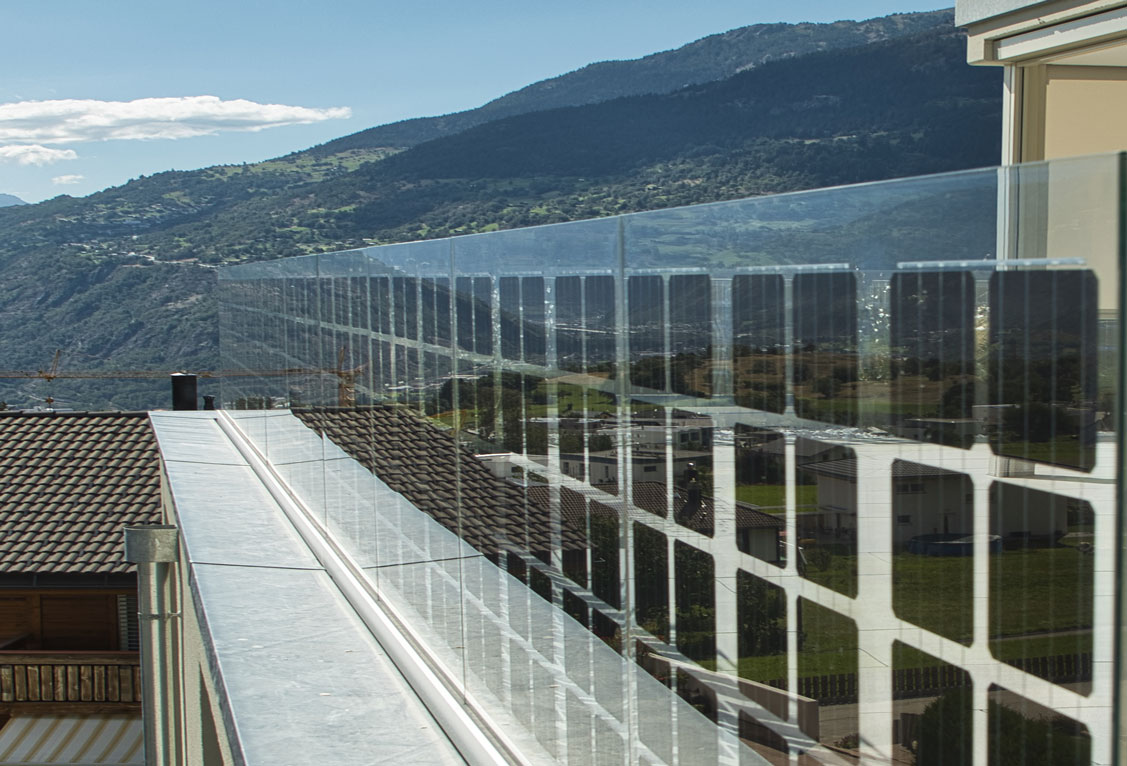Solar modules for patio and sun-porch integration
Daylight & sun shield thanks to semi-transparent solar panels with high-efficiency solar cells
Thanks to the implementation of high-efficiency solar cells, even our semi-transparent solar modules excel in performance and not only allow enough daylight to pass into interiors but rather create for pleasant atmospheres inside by perfect light control. At the same time, our modules act as sun shields. So further means of sun screening are not necessary anymore. The solar glass, our panels are made of, is extremely resistant to heavy loads and impacts. This allows us to provide the guarantee that our modules comply with all the requirements and regulations on statics and overhead glazing, also in snow areas.
For the open overhead glazing of patios or terraces, a module construction in glass-glass technology is to be considered sufficient; in closed rooms such as sun-porches or winter gardens however, which are to ensure for a pleasant interior climate and thermal insulation, the solar modules are constructed as insulating glass laminates.
We reduce your electricity costs by using solar glass
As a high-performance specialist in the industry of solar energy, we develop and build innovative PV solutions all around buildings. Whether as patio or sun-porch, our solar terrace or winter garden modules set an optical high-light which provides shadow while reducing your electricity costs.
Our service
At a2-solar, we offer you the following:
- Highest German Quality and Experience
- Individual quotes customized according to request details, considering all architectonic aspects and requirements
- In-time delivery
- Reliable partner
- individual modules customized in design, shape and sizes which perfectly fit into your or already existing construction / grid dimensions
Why to choose for solar glass?
- Long life circles
- High load capacities
- Hail resistance
- Safety
- Glare-free
- Innovative characteristics
- Increased solar yields
Do you know the difference between normal and solar glass?
In contrast to normal window glass the solar glass differs chemically with a lower iron content. When looking at the edges of a glass pane, the difference becomes visible: the window glass has green color shades while the photovoltaic glass appears clear with a light blue shade.
What characterizes solar glass?
Solar glass - also called photovoltaic glass - is a special glass which - in comparison to normal window glass - allows for a 10% higher transmission due to lower iron contents; hence the energy input for the solar application will be increased. Solar glass panes are also used for special architectural applications; for photovoltaic modules and solar collectors, however, it is the only choice. Also, the following additional requirements need to be taken into account: solar glass applications are exposed to high mechanical loads and heat differences. Therefore the solar glass must be tempered to avoid breakages. Especially with regard to heavy snow loads and hail impacts, the regulations for breaking resistance are extremely high. However, specific fields of application request glass thicknesses to be as small as possible. Photovoltaic glass is produced in different thicknesses (from 2 to 19 mm) and dimensions (up to 6 m x 3.21 m) and can be additionally refined with individual coatings such as anti-reflective layers.
Why photovoltaic glass is so special?
Apart from the low iron content - which leads to an improved permeability of the energetic radiation - the characteristic tempering process is crucial for solar applications. Due to the thermal pre-stressing process, solar glass is given a better mechanical stability. Compressive stresses on the surface and tensile stresses in the middle are built up inside the photovoltaic glass. As a result, photovoltaic glasses resist higher mechanical strains, e.g. high load deflections when subject to mechanical impacts. Tempered glass - also known as single-pane safety glass (ESG) - is also used for a car’s side and rear windows: if the glass breaks, the pane cracks into thousands of small glass splinters to prevent serious injuries.
The glass in the photovoltaic industry
Despite the increasing importance of photovoltaics, solar glass only constitutes a minor part of the entire flat glass production. During the manufacturing process for photovoltaic glass panes there is a distinction into two glass types: the cast glass and the float glass.
Cast glass process: the liquid glass mass is formed into a glass ribbon between two cooled rollers and refined with a surface structure. On a cooling path the glass ribbon is then cooled down to room temperature in an endlessly continuous process and then cut into plates. Due to technical and commercial issues however, this process does not allow to produce the high-quality, transparent glass pane covered with the specific surfaces required for implementation in the building sector.
Still, the solar glass produced by this process generally satisfies the requirements for the solar input since solar modules do not require any optical transparency. Standard thicknesses are 3 mm and 4 mm.
Float glass process: this process is also referred to as an endless continuous process, however, the glass mass in this process is poured onto a liquid tin bath. Due to the difference in density between glass and tin, the glass melt floats as a film on the tin like an oil-film on a water surface. The interactive surface tension of the tin and the glass creates a glass surface with very low roughness and high smoothness to develop – the so called “mirror glass”. This product, also known as “basic glass”, accounts for approximately 95% of the world's flat glass business. The glass ribbon solidified on the cooler end of the bath is pulled out continuously and then passes through a cooling channel of about 500 m long, in which it is cooled down free of tension. After an optical quality control, the glass ribbon is then cut into the standard sizes 6 m x 3.21 m. Glass thicknesses of 2 to 19 mm can be realized.
We are your contacts for any question about Building-integrated PV.

Reinhard Wecker
Building-integration Germany and international.




